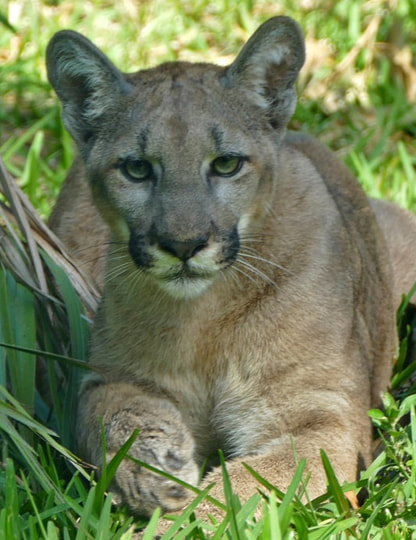Florida's Feline: A Southern Survivor's Rising Numbers
|
Florida Panther Puma concolor coryi
The Florida panther is a subspecies of a large cat that ranges from Alberta to Argentina across large swaths of North, Central, and South America. In other parts of the US, this species is also known as a cougar, mountain lion, or puma. The Florida panther is the only known breeding population of this cat in the eastern United States and is a federally protected endangered species. It is also the official state animal of Florida. |
|
Physical Description At birth, panthers are about a pound (0.5 kg) and are spotted. As they mature, they lose the spots and have an even tawny-colored coat. Adult panthers stand 24 to 28 inches (61 to 71 cm) tall at the shoulder measuring between 6 and 7 feet (1.8 to 2.1 m) from nose to the end of the tail. Males weigh between 100 to 160 lbs (45 to 72 kg) and females between 70 and 100 lbs (32 to 45 kg). |
Against the Odds
Remarkably, even after centuries of eradication efforts, pumas are still one of the most widely-distributed mammals in the Western Hemisphere. In the US, pumas were eliminated east of the Great Plains nearly a century ago except for the cats in Florida. In western North America, populations are still robust enough to allow a regulated harvest. A few males have even been documented traveling into their historic eastern range. While The IUCN Red List of Threatened Species notes that pumas are declining overall with some populations in South America considered either Near Threatened or Vulnerable to extinction, it does indicate this species has a lower risk of going extinct.
Remarkably, even after centuries of eradication efforts, pumas are still one of the most widely-distributed mammals in the Western Hemisphere. In the US, pumas were eliminated east of the Great Plains nearly a century ago except for the cats in Florida. In western North America, populations are still robust enough to allow a regulated harvest. A few males have even been documented traveling into their historic eastern range. While The IUCN Red List of Threatened Species notes that pumas are declining overall with some populations in South America considered either Near Threatened or Vulnerable to extinction, it does indicate this species has a lower risk of going extinct.
Saving the Survivors
In Florida, a couple dozen panthers survived into the 1970s when attitudes had shifted from persecution to protection. Unfortunately, these cats were isolated. Prior to the loss of cats in the East, genes from the western pumas and Eastern cougars would naturally flow into the population around the boundaries of the subspecies. Like traits passed through European royalty because of their limited choice of royal spouses, inbreeding among these panthers amplified the presence of genetic defects affecting their health and reproductive success. By the 1990s, modeling suggested these traits would kill off the Florida population within 20 years. To prevent this extinction, a genetic restoration effort in 1995 temporarily introduced female pumas from Texas.
In Florida, a couple dozen panthers survived into the 1970s when attitudes had shifted from persecution to protection. Unfortunately, these cats were isolated. Prior to the loss of cats in the East, genes from the western pumas and Eastern cougars would naturally flow into the population around the boundaries of the subspecies. Like traits passed through European royalty because of their limited choice of royal spouses, inbreeding among these panthers amplified the presence of genetic defects affecting their health and reproductive success. By the 1990s, modeling suggested these traits would kill off the Florida population within 20 years. To prevent this extinction, a genetic restoration effort in 1995 temporarily introduced female pumas from Texas.
Like royal families, bringing in new bloodlines allowed healthy offspring to come from a sickly parent. Today, traces of genetic material from the Texas cats are infused throughout the population. Without it, headlines would likely have already announced the death of the last Florida cat by now.
Growing Populations of People and Panthers
Even as the number of people in south Florida and the places we live greatly expanded, the numbers of healthier panthers also grew. That created more chances for people and panthers to cross paths. We're seeing this in the dramatic increase of sightings and photos being taken of wild panthers. But it's also tragically seen when a panther is killed by a vehicle or when a panther kills a backyard pet or calf on a ranch. And so, this moment of pride brings both controversy and new opportunities to do better for panthers and the people who live among them. See what can be done to help people and panthers.
The Value of Predators
Across the world, we find predators maintain the balance of animals whose overpopulation negatively impacts us. A recent study points to predators reducing the prevalence of diseases we can catch. Additional research also shows people benefit from the important role predators play in nature. (Journal Article) The loss of these beneficial roles can be seen in areas where top predators have been eliminated. Societal awareness of these benefits compared to the obvious negative impact appears to be limited. Of course, even with good knowledge about these pros and cons, people will vary in their personal views on the value of large predators based on many real factors.
Growing Populations of People and Panthers
Even as the number of people in south Florida and the places we live greatly expanded, the numbers of healthier panthers also grew. That created more chances for people and panthers to cross paths. We're seeing this in the dramatic increase of sightings and photos being taken of wild panthers. But it's also tragically seen when a panther is killed by a vehicle or when a panther kills a backyard pet or calf on a ranch. And so, this moment of pride brings both controversy and new opportunities to do better for panthers and the people who live among them. See what can be done to help people and panthers.
The Value of Predators
Across the world, we find predators maintain the balance of animals whose overpopulation negatively impacts us. A recent study points to predators reducing the prevalence of diseases we can catch. Additional research also shows people benefit from the important role predators play in nature. (Journal Article) The loss of these beneficial roles can be seen in areas where top predators have been eliminated. Societal awareness of these benefits compared to the obvious negative impact appears to be limited. Of course, even with good knowledge about these pros and cons, people will vary in their personal views on the value of large predators based on many real factors.
|
Panther Numbers Going Up
While Florida panthers face threats from vehicle collisions to habitat loss, their numbers are on the rise with an estimate of up to 230 adult panthers and their additional offspring in south Florida. While this is a commonly cited number, it's important to understand that the US Fish and Wildlife Service and the Florida Fish and Wildlife Conservation Commission openly state this figure is not a scientifically valid population estimate, but the best available using the techniques available with this species that is so challenging to count. (Read the full Florida Panther Population report.) Need for Collared Cats Going Down When very few panthers roamed Florida, it was crucial to track cats and understand what they needed to survive. But after decades of research, much has been learned and the need to collar cats has been greatly reduced. Today, typically less than 1 in 20 cats would have a GPS or radio collar. More information on the Florida panther. |
Report a Panther Sighting
If you have images of panthers or photos of panther tracks, especially north of the Caloosahatchee River, you can submit your photos to the Florida Fish and Wildlife Conservation Commission.
If you have images of panthers or photos of panther tracks, especially north of the Caloosahatchee River, you can submit your photos to the Florida Fish and Wildlife Conservation Commission.
The Genetic Question: Are Florida Panthers Still a Thing?
The Florida panther was first described as a unique subspecies on the basis of morphological characteristics, primarily the differences in skull morphology relative to other puma populations in North and South America. Research published in 2000 suggested that an extinction event eradicated pumas from North America about 10,000 years ago. According to the authors, the puma likely recolonized North America from South America and that genetic analyses provide support for a single North American subspecies. More recently, an expert group convened on behalf of the IUCN SSC Cat Specialist Group also recognized that the puma in North America represent a single subspecies. There is no debate that the Florida panther represents the only breeding population of puma in the Eastern United States. And even if all North American pumas are classified as the same subspecies, the Florida cats could still find protection through the Endangered Species Act as a Distinct Population Segment. The U.S. Fish and Wildlife Service is currently reviewing the best available science on puma taxonomy as part of their 5-Year Status Review of the Florida panther.
|
|
The intent of this video and website are to highlight the complexity of Florida panther recovery and to give voice to the diversity of stakeholders involved and affected. Panthers are part of Florida's heritage and can play a significant role in the future of the state through ongoing protection of public lands as well as conservation easements and other programs that enable private landowners to maintain large wild spaces. This video was created through a collaboration between Big Cypress National Preserve, Florida National Parks Association, Naples Zoo at Caribbean Gardens, and the South Florida National Parks Trust. The website is an effort of the Naples Zoo.
|
|
This website and its contents are funded and maintained by the Naples Zoo Conservation Fund Naples Zoo at Caribbean Gardens | 1590 Goodlette-Frank Road | Naples FL 34102 | 239.262.5409 | email | website |



